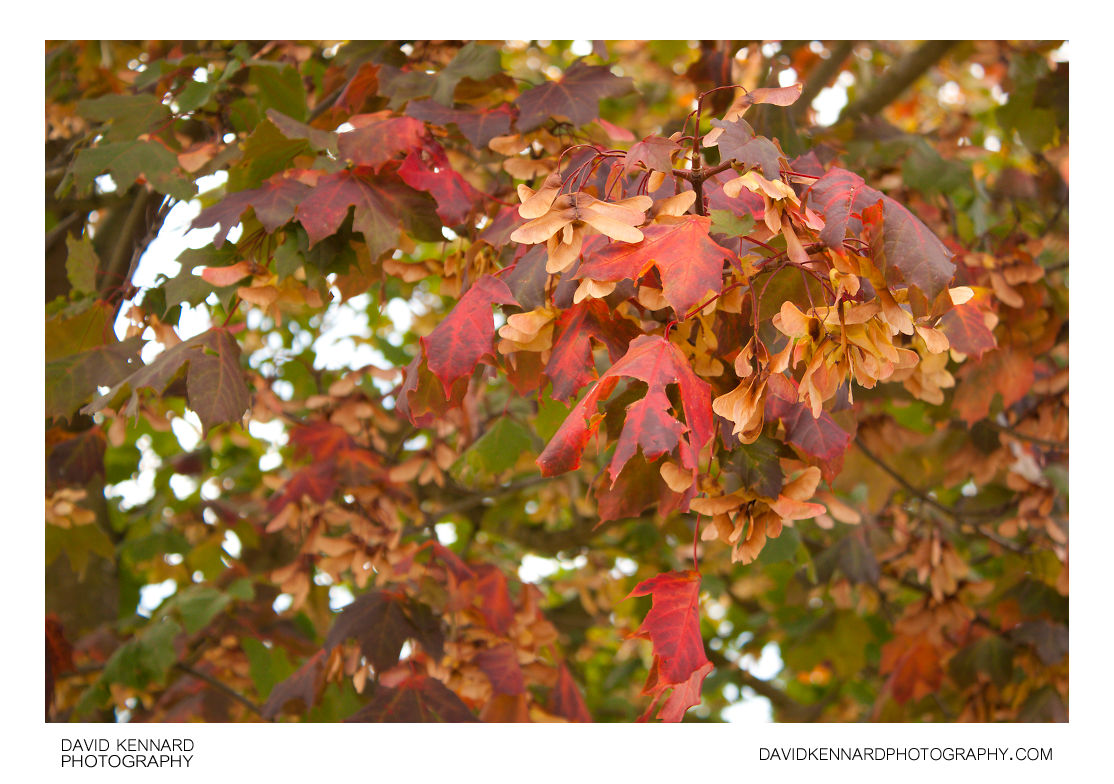Sycamore seeds, early autumn

Description
- Title:
- Sycamore seeds, early autumn
- Caption / Description:
-
Acer pseudoplatanus, Sycamore (or Sycamore Maple, to distinguish it from other plants called sycamore) is a species of maple native to central Europe and southwestern Asia, from France east to Ukraine, and south in mountains to northern Spain, northern Turkey, and the Caucasus.
In Scotland, the Sycamore is known as the Plane tree, although it is not a member of the Platanus genus. Its apparent similarity to the plane led to its being named pseudoplatanus, using the prefix pseudo- (from the Ancient Greek for "false").
It is a large deciduous tree that reaches 20–35 m tall at maturity, with a broad, domed crown. On young trees, the bark is smooth and grey but becomes rougher with age and breaks up in scales, exposing the pale-brown-to-pinkish inner bark.
The leaves are opposite, 10–25 cm long and broad with a 5–15 cm petiole, palmately veined with five lobes with toothed edges, and dark green in colour; some cultivars have purple-tinged or yellowish leaves. The leaves are often marked with black spots or patches which are caused by the fungus Rhytisma acerinum.
The monoecious yellow-green flowers are produced in spring on 10–20 cm pendulous racemes, with 20–50 flowers on each stalk. The 5–10 mm diameter seeds are paired in samaras, each seed with a 20–40 mm long wing to catch the wind and rotate when they fall; this helps them to spread further from the parent tree. The seeds are mature in autumn about 6 months after pollination.
Description adapted from Wikipedia: http://en.wikipedia.org/wiki/Acer_pseudoplatanus
- Tags / Keywords:
-
- Biota
- Life
- Vitae
- Eukaryota
- Plantae
- Plants
- Magnoliophyta
- Flowering Plants
- Angiosperms
- Magnoliopsida
- Dicotyledons
- Red
- Autumn
- Sapindales
- Sapindaceae
- Soapberry family
- Acer
- Maples
- Acer pseudoplatanus
- Sycamore Maple
- Sycamore Seeds
- Helicopter seeds
Admin
- Date Original Photo Taken:
- Original File Name:
- _MG_8602.CR2
- Event:
- Rating:
- ☆
- Date this image added/last updated on website:
- Original File Dimensions:
- 4272px x 2848px
- File Type:
- JPEG
- Color Mode:
- Original Image Color Profile:
- Adobe RGB (1998)
Location
- Location Created:
-
- Sublocation:
- City:
- Market Harborough
- Province/State:
- Leicestershire
- Country:
- United Kingdom
- World Region:
- Europe
- Geo-location:
- 52.474458333333, -0.93887166666667 View on map
Rights
- Copyright Status:
- Copyrighted
- Licensing Status:
- Rights Managed
- Available for Editorial Use:
- Yes
- Available for Commercial Use:
- Yes
- Copyright Notice:
- © 2011 Dave Kennard
Camera Data
- Date Digital Resource was created:
- Shutter speed:
- 1⁄200 s
- Aperture:
- f/5.6
- Camera Model:
- Canon EOS 450D
- ISO:
- 400
- Exposure Compensation:
- 0
- Focal Length:
- 55mm
- Focal Length (35mm equiv.):
- Metering Mode:
- Multi-segment
- Flash:
- Off, Did not fire
- Exposure Mode:
- Manual
- White Balance:
- Manual
- Light Source:
- Exposure Program:
- Manual
Additional shooting metadata
- Lens:
- Canon EF-S 18-55mm F3.5-5.6 II USM
- Filters used:
- Additional Optics used:
- Setup:
- Handheld
Liveview using Hoodeye LCD viewfinder
Post Processing
- Image Modified:
- Software used:
-
- Adobe Camera RAW
- Post Processing:
